By Mike Darwin
Reaching for Extracorporeal Excellence

Figure 27: Tamari-Kaplitt Pulsator being used for cryoprotective perfusion of a patient on 12 December, 1988.
From the time Jerry and I took charge of patient care at Alcor, both standard and cutting edge extracorporeal medical technology was applied to cryonics patients with both a high degree of competence and success.[1] That does not mean that we had the latest equipment, or the most elegant surroundings, because we usually did not. Nor do perfusionists or intensivists in New Zealand, or in the UK today, and yet despite (or perhaps because of) a relative paucity of the very latest devices in their ICUs and ORs, their patient outcomes, in terms of both morbidity and mortality, are better, on average, than those in the US – and these outcomes are achieved at markedly lower costs.22,23 Years before US intensivists abandoned the routine use of pulmonary artery catheters (Swan-Ganz catheters), their use had been discontinued completely in New Zealand’s ICUs: there is no substitute for good clinical judgment and the intelligent use of technological resources.
After validating that pulsatile flow was significantly better at facilitating cryoprotective equilibration and controlling cerebral edema in ischemic cryopatients (using an animal model employing the radioactive microsphere technique for determining regional flows), we acquired a Tamari-Kaplitt Pulsatile (TKP) flow device, 24 which was used until the manufacturer, Shiley, ceased making the disposable component of the system. The TKP produced truly effective pulsatile flow, and was ideal for use in cryonics operations, because it could be used with hollow fiber oxygenators and, when used under the asanguineous, low-flow, low and slow pulsatility conditions necessary for CPA perfusion, the TKP did not present the risk of cavitation of the perfusate (and accompanying gas embolus formation) or hemolysis that it did in normal clinical use.25

Figure 28: Disposable pulsator chamber of the Tamari-Kaplitt Pulsator (foreground). A chamber comprised of a flexible membranous section of the arterial line, contained within a hard outer shell, generated pulsatile flow using compressed gas. Shiley discontinued manufacturing this component rendering the device obsolete and unusable.
While inferior to the TKP in generating pulsatile flow, we acquired a Sarns DX Pulsatile Pump early in 1990 at the then (to us) staggering cost of $4,500.
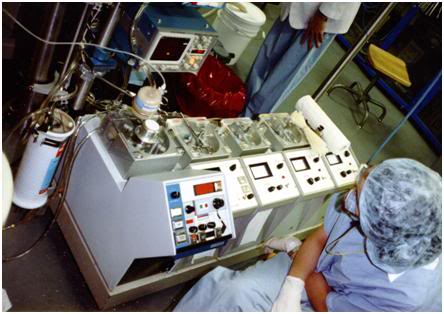 Figure 29: Sarns DX pump (left side of the heart-lung machine console) being used with a Kolobow silastic membrane oxygenator to provide pulsatile flow for a patient on 31 December, 1990. An added expense that accompanied the loss of the TKP was the need to use Kolobow ‘true membrane’ oxygenators in order to minimize damping of the pulse wave that occurs with hollow fiber oxygenators. The TKP pulsation generator bypassed the oxygenator and was positioned in-line, adjacent to the arterial cannula.
Figure 29: Sarns DX pump (left side of the heart-lung machine console) being used with a Kolobow silastic membrane oxygenator to provide pulsatile flow for a patient on 31 December, 1990. An added expense that accompanied the loss of the TKP was the need to use Kolobow ‘true membrane’ oxygenators in order to minimize damping of the pulse wave that occurs with hollow fiber oxygenators. The TKP pulsation generator bypassed the oxygenator and was positioned in-line, adjacent to the arterial cannula.
However, all the extracorporeal acumen in the world cannot make up for prolonged exposure to normothermic ischemia, and here too Alcor was a leader, both in applying existing technology for cardiopulmonary support (CPS), and in extending it to well beyond what clinical medicine had to offer at that time. By November of 1985 we had deployed emergency response kits equipped with a mechanical heart-lung resuscitator (HLR), 1st generation cerebroprotective drugs, cooling equipment (Portable Ice Baths, PIBs) and temperature monitoring equipment to the US, Canada and the UK.26 Also included were small compressed oxygen cylinders as well as oxygen regulators to interface with high capacity H-cylinders to allow for extended HLR run times.
What’s more, we had also acted aggressively to equip the South Florida Alcor group with full capability for Standby, Transport, and cryoprotective perfusion. We also established periodic training sessions using a survival animal model as well as didactic and hands-on training sessions held more frequently to establish and maintain emergency response and Transport skills. 27
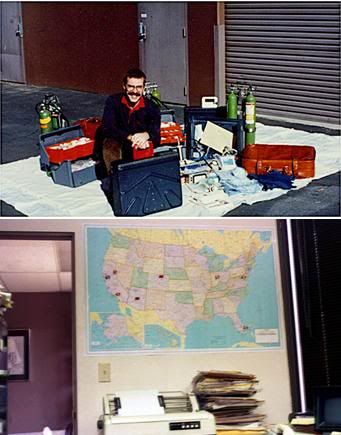 Figure 30: At top, Mike Darwin, with the 1st generation of emergency response kits just prior to their deployment in 1985; and at bottom, the map of the US showing the location of emergency kits and of all Alcor members as of May, 1986.
Figure 30: At top, Mike Darwin, with the 1st generation of emergency response kits just prior to their deployment in 1985; and at bottom, the map of the US showing the location of emergency kits and of all Alcor members as of May, 1986.
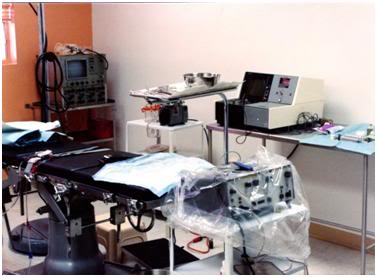 Figure 31: Operating room in the Alcor South Florida facility in May of 1987; invasive pressure monitoring equipment on cart at left, hot suction on white cart at center, defibrillator & monitor on stainless steel back table at upper left, electrocautery on cart in foreground, and operating table lower left.
Figure 31: Operating room in the Alcor South Florida facility in May of 1987; invasive pressure monitoring equipment on cart at left, hot suction on white cart at center, defibrillator & monitor on stainless steel back table at upper left, electrocautery on cart in foreground, and operating table lower left.
These training sessions were held on-site to facilitate participation by the maximum number of local members possible, and additional training was conducted at Alcor’s facilities in Fullerton, and later in Riverside, CA.
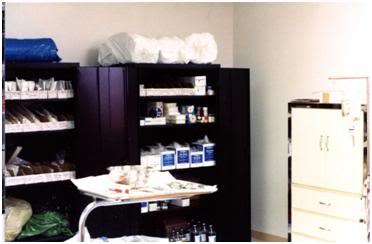 Figure 32: Extracorporeal supplies cabinets in the Alcor Florida facility in May of 1987.
Figure 32: Extracorporeal supplies cabinets in the Alcor Florida facility in May of 1987.
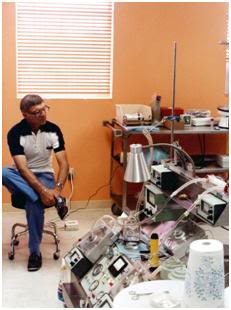 Figure 33: Alcor member Gil Ross looks on as preparations are underway for a training session. In the foreground is the American Optical heart-lung machine which was to be used for cryoprotective perfusion in the South Florida facility.
Figure 33: Alcor member Gil Ross looks on as preparations are underway for a training session. In the foreground is the American Optical heart-lung machine which was to be used for cryoprotective perfusion in the South Florida facility.
Only someone who was willfully ignorant or malicious could look at these photos and read the published accounts of the time (which are readily accessible on-line) and claim that cryonics, at least as practiced by Jerry Leaf and I, was in any way divorced from extracorporeal medicine and technology. What is seen, and seen consistently, is the use of conventional medical technology, and in particular conventional perfusion technology, to such an extent that it would be difficult to differentiate any of these facilities as being cryonics operations, as opposed to CPB surgical suites in experimental laboratories or clinical environments around the world at that time.
Training sessions in basic emergency response were frequent, lasted several days, and were achievement validated; individuals either mastered the skills sets required and passed the exams, or they were not certified as Level 1 Transport Techs.
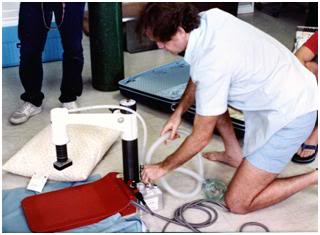 Figure 34: Saul Kent practicing set-up of the Michigan Instruments 1008 heart-lung resuscitator during a training session conducted in South Florida, circa 1987.
Figure 34: Saul Kent practicing set-up of the Michigan Instruments 1008 heart-lung resuscitator during a training session conducted in South Florida, circa 1987.
And no one was exempt from DIY cryonics. There was very little money in those days and the people who wanted cryonics for themselves had no choice but to learn to do it for themselves. Equipment was purchased used, often for pennies on the dollar, and with the exception of myself and Hugh Hixon, no one was paid in any way for their services (and Hugh and I were paid precious little).
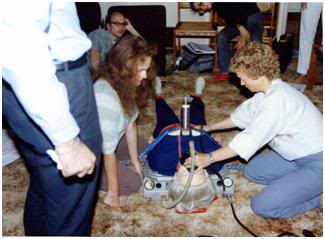 Figure 35: Left to right: Thomas Donaldson, Cath Woof and Linda Chamberlain practicing applying and operating the Brunswick HLR-50-90 at an Alcor Transport training session hosted by the Donaldson’s at their home in Sunnyvale, California.28
Figure 35: Left to right: Thomas Donaldson, Cath Woof and Linda Chamberlain practicing applying and operating the Brunswick HLR-50-90 at an Alcor Transport training session hosted by the Donaldson’s at their home in Sunnyvale, California.28
It is egregiously malicious, as has been done recently, to ridicule some of the very people who were down on their hands and knees in these photos learning to do for themselves, as best they could, what virtually no medical professionals at that time were willing to teach – let alone to do. Even had we had the money (which we did not), it was impossible to find professionals with both the skills and the time to do the jobs we were forced to do ourselves – though let the record note that we certainly tried mightily to recruit such people, and in a few cases succeeded. But it was never enough to equal the task at hand. The need to earn a livelihood, as well as geographical distance, proved formidable barriers.
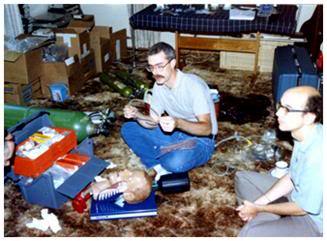 Figure 36: Mike Darwin and Thomas Donaldson preparing to practice endotracheal intubation skills at an Alcor Transport training session hosted by the Donaldson’s at their home in Sunnyvale, California.
Figure 36: Mike Darwin and Thomas Donaldson preparing to practice endotracheal intubation skills at an Alcor Transport training session hosted by the Donaldson’s at their home in Sunnyvale, California.
As early as February of 1985 we began the practice of in-field blood washout of cryopatients (TBW) at local mortuaries and this practice was routinely implemented for every Alcor patient who could benefit from it.[[2]] 29-32 Why was this done in mortuaries as opposed to in the hospitals where the patients were pronounced? The answer is that there was no medical facility who would even consider allowing such care to proceed in their facilities – which was a moot point anyway, since no physician or technician on their staff was interested in assisting with, let alone undertaking such a task on their own initiative. One of my most vivid memories of a patient Transport was when a staff physician at the hospital where I was undertaking to Transport the patient – literally connecting the patient to the HLR and intubating him – walked into the ICU cubicle and began to rail at me about what the patient’s future employment prospects would be, and who would pay to reeducate him if he was revived![3] The majority of physicians then, as is the case with those who now attack cryonics, while loudly professing their desire to save it, not only don’t want to help cryonicists – they want to destroy cryonics.
After years of scrounging, scrimping and saving, Jerry Leaf and Hugh Hixon completed construction of a mobile ‘extracorporeal membrane oxygenation’ (ECMO) cart.33 This device was fabricated in-house, not just because we had virtually no money, but because there was no commercial manufacturer for such a piece of equipment when the project was begun in 1982 – and indeed there was no commercial manufacturer after it was completed in 1986, either. In fact, 25 years later, there are still no commercially produced integrated adult ECMO carts! The cart was first applied to a young man, who unexpectedly arrested from sepsis secondary to HIV, on 08 June, 1987.34
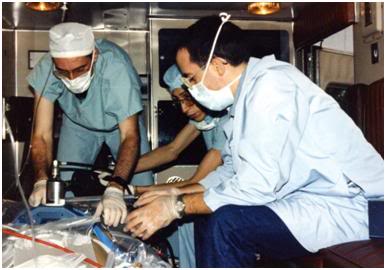 Figure 37: Patient undergoing mechanical CPS as a bridge to ECMO support in the Alcor ambulance in June of 1987. Left to right above are: Mike Darwin, CRT, Carlos Mondragon and Scott Greene, RN.
Figure 37: Patient undergoing mechanical CPS as a bridge to ECMO support in the Alcor ambulance in June of 1987. Left to right above are: Mike Darwin, CRT, Carlos Mondragon and Scott Greene, RN.
The patient was transported from the hospital where he arrested to Alcor’s facilities in Riverside, CA using closed chest mechanical CPS as a bridge to ECMO. The three photos below illustrate the extracorporeal circuit and the configuration of the 1st generation cryonics ECMO cart, which was christened the Mobile Advanced Life Support System (MALSS).
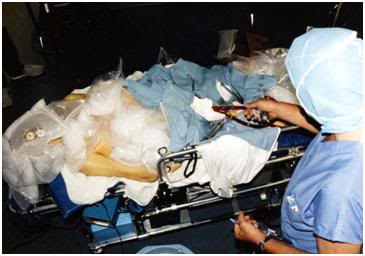 Figure 38: Jerry Leaf preparing to install aneroid ‘back pressure ‘ monitoring gauge on the arterial filter of the bypass circuit.
Figure 38: Jerry Leaf preparing to install aneroid ‘back pressure ‘ monitoring gauge on the arterial filter of the bypass circuit.
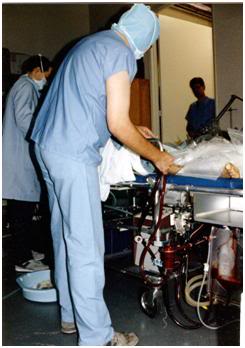
Figure 39: Jerry Leaf, preparing to secure the arterial and venous lines to the lower structural support rail of the MALSS, while Scott Greene, RN, suctions the patient.
 Figure 40: The patient on CPB undergoing cooling to 15oC prior to blood washout and cryoprotective perfusion.
Figure 40: The patient on CPB undergoing cooling to 15oC prior to blood washout and cryoprotective perfusion.
Where use of the MALSS was not feasible due to distance or logistics, in-field CPB with blood washout continued to be used, as is illustrated in Figure 41.
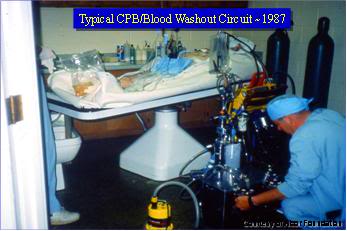
Figure 41: Jerry Leaf prepares the in-field CPB circuit for connection to Dr. Eugene Donovan, M.D., who was cryopreserved by Alcor on 21 March, 1989. The patient is receiving continuous cardiopulmonary support via a pneumatically powered chest compressor and ventilator.
After Jerry was cryopreserved in July of 1991, Alcor continued to offer extracorporeal and cryonics care that was of extraordinarily high quality. As a result of in-house research on developing improved methods of CPS, Alcor began the use of high impulse CPR (HI-CPR); a modality that has only within the past year become the standard of care in the US. I worked closely with Michigan Instruments, spending a week in Grand Rapids, to develop of a heart-lung resuscitator capable of delivering HI-CPR.35
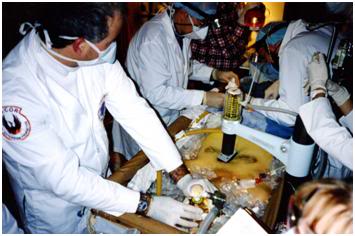 Figure 42: Patient undergoing high impulse CPS as a bridge to CPB cooling and blood washout on 12 December, 1991.
Figure 42: Patient undergoing high impulse CPS as a bridge to CPB cooling and blood washout on 12 December, 1991.
On 12 December, 1991 Alcor placed the first human cryopatient on CPB in his home. HI-CPR, starting within 2 minutes of pronouncement, served as a bridge to CPB which was initiated within~100 minutes of cardiac arrest.36

Figure 43: CPB supported induction of ultraprofound hypothermia being undertaken in the living room of a cryopatient’s home for the first time, on 12 December, 1991.
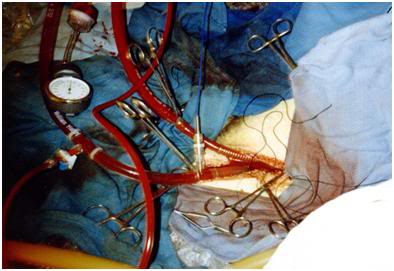 Figure 44: Femoral cannulae, arterial and venous lines, pressure monitoring line and aneroid, 12 December, 1991.
Figure 44: Femoral cannulae, arterial and venous lines, pressure monitoring line and aneroid, 12 December, 1991.
End of Part 4
References
24) Kaplitt MJ, Tamari Y, Frantz SL, et al. Clinical experience with Tamari-Kaplitt pulsator. NY State J Med. 1978;78:1090.
25) Wise EA, Mandl JP, Zaayer WE. Gaseous emboli generation by a pulsatile assist device. J Extracorp Tech. 1978;10:93.
26) Editorial Staff. ALCOR Coordinators: Training and Equipment Deployment. Cryonics. 7(1);1986:2-4. http://www.alcor.org/cryonics/cryonics8601.txt. Retrieved 2011-01-24.
27) Editorial Staff, CSSF merges with Alcor. Cryonics. 6(1);1985:2-6: http://www.alcor.org/cryonics/cryonics8501.txt. Retrieved 2011-01-24.
28) Adventure in Sunnyvale. Cryonics. 7(9);1986:5-8: http://www.alcor.org/cryonics/cryonics8609.txt. Retrieved 2011-01-24
29) Darwin, MG, Leaf, JD, Hixon, H. Case report: neuropreservation of Alcor patient A-1068. 1 of 2, Cryonics. 7(2);17-32:1986: http://www.alcor.org/cryonics/cryonics8504.txt. Retrieved 2010-08-31. Retrieved 2011-02-25.
30) Darwin, M, Bridge S. The cryonic suspension of A-1242. Cryonics 11(10)1990:18-22. 2010-09-29. http://www.alcor.org/cryonics/cryonics9010.txt. Retrieved 2010-09-29. Donovan, C and Donovan, J. A dream in his pocket: the cryonic suspension of Eugene T. Donovan. Cryonics. 11(2);29-45:1990: http://www.alcor.org/Library/html/casereport9002.html. Retrieved 2011-01-28.
31) Darwin, MG, Cryopreservation case report: Arlene Francis Fried, A-1049: http://www.alcor.org/Library/html/fried.html. Retrieved 2011-01-30.
32) Henson, K, Darwin, M. The Transport of Patient A-1312S. http://www.alcor.org/Library/html/casereport9202.html. Retrieved 2010-08-31.
33) Leaf, J, Hixon, H, Darwin, M. Development of a mobile advanced life support system for human biostasis operations. Cryonics. 1987; 8(3):23-40: http://www.alcor.org/cryonics/cryonics8703.txt. Retrieved 2011-01-24.
34) Darwin, M. Cryonic suspension case report A-1133. http://www.alcor.org/Library/pdfs/AlcorCaseA1133.pdf. Retrieved 2011-01-24.
35) Darwin, M. A major advance in suspension patient support. Cryonics. 10(8):1989:7-14. http://www.alcor.org/cryonics/cryonics8908.txt. Retrieved Retrieved 2011-01-24.
36) Henson, K, Darwin, M. The Transport of Patient A-1312S. http://www.alcor.org/Library/html/casereport9202.html. Retrieved 2010-08-31.
[1] Success being defined here is effective cryoprotective loading, absence of iatrogenic events and in those cases where it was possible, preservation of viability until cryoprotective perfusion was undertaken.
[2] Some patients were not candidates for this treatment as a result of being Coroner/Medical Examiner cases, or experiencing unanticipated and distant cardiac arrest.
[3] My retort was that the good Doctor shouldn’t worry about having to pay for those things, because unless he was cryopreserved himself, he would be long dead and buried before the patient was reanimated.


you wrote:
“One of my most vivid memories of a patient Transport was when a staff physician at the hospital where I was undertaking to Transport the patient – literally connecting the patient to the HLR and intubating him – walked into the ICU cubicle and began to rail at me about what the patient’s future employment prospects would be, and who would pay to reeducate him if he was revived![3] The majority of physicians then, as is the case with those who now attack cryonics, while loudly professing their desire to save it, not only don’t want to help cryonicists – they want to destroy cryonics.”
=================
you threaten their culture, their place in society, you threaten their god, threaten their faith. It seems that all you want to do is preach to the choir, and get the approval of your peers. And reap some benefits from such.
You care little for probing deeper and solving real problems.
Ponder this quote from the movie CONAN THE BARBARIAN:
“Conan: The riddle… of steel.
Thulsa Doom: Yes! You know what it is, don’t you boy? Shall I tell you? It’s the least I can do. Steel isn’t strong, boy, flesh is stronger! Look around you. There, on the rocks; a beautiful girl. Come to me, my child…
Thulsa Doom: [coaxes the girl to jump to her death]
Thulsa Doom: That is strength, boy! That is power! What is steel compared to the hand that wields it? ”
This quote exemplifies the naive thinking behind cryonics. Science, yes, it is wonderful. But it has a long way to go. Some day it may make us immortal. But there are many a decade, many a century yet to pass. Cryonics try to appeal to the rational side of man, but in this area, there is little rationality, and that is not going to change anytime soon. Better to use the other strength of mankind, religion.
What is science and reason compared to the power of religion when it comes to the area of life after death?
Jeez, Un. Can’t you make a better argument than playing a version of Rock Paper Scissors? BTW, as I recollect the movie, Conan used steel to behead Thulsa Doom any way.
Here’s the deal: There is this Forum called Cold Filter. It’s a place where people can vomit, or ejaculate all over each other, pretty much as they please. It has gotten more civil of late, but what it has not gotten is any more productive. If you are pushing 60, or are otherwise in ill health, and most of the people you started out with in cryonics, including your cohorts, or those just a little older, are now dead, cryopreserved, or otherwise inactivated by time, you lose all patience with this kind of foolish, and non-productive dialogue. Both of you are, broadly speaking, right. I agree that religion, in the sense of reverence for and worship of the transcendent, is inextricably a part of our identities as humans – and will likely continue to be so till the end of time, as we now it. Any system that fails to acknowledge and harness that advantage (and it is an advantage), will fail.
It is also true, as Mark Plus asserts, that Bible thumping, ‘old time religion’ is incompatible with a rational, scientific view of the world. What’s more, “Unperson,” you should travel more, if you can. In most of Western Europe, ‘old time religion’ is mostly vestigial, and the churches are largely being recycled, or are used as social clubs with religious trappings. If a politician so much as invoked religion in the UK, or most of Europe, he would be laughed out of office. They think people in the US are ‘crazy,’ and they are right. Buses in Germany, France and the UK sport placards on their sides advocating atheism… The world is a big and diverse place, and I can tell you that in most of the West outside the US, any appeal to Fundamentalism, or even organized religion, is the political kiss of death – literally – and this from the masses, not the elite.
Having said all that, I am well aware that I am very unlikely to change either of your opinions – and that’s OK. I’m not looking to convince any but a very few of the existing ‘base’ in cryonics and TH, and those I’ll mostly know when I see them. And when I do, I won’t care if they believe in Beelzebub or Jesus, as long as they get the important parts of behaving like a responsible and decent human being right – as well as consistently behaving as a committed cryonicist. I’m deeply amused by the Transhumanists who aspire to this vague, but presumably superior state of being, without first having mastered being human. The latter, as it turns out, is a surprisingly hard task, and one that must precede the former
Unperson, I have looked at your long, long string of repetitive posts to CF. They are non-productive. Do you expect someone to hear your message? And if they do, then what? If you want a Fundamentalist Cryonics Christian religion, then you best get your brain, as well as your arse in gear, and create it. Because you will need a theology, a liturgy, a morality, a narrative, and an eschatology – just for starters. It needn’t make much sense, and it certainly needn’t be well written; consider the Book of Mormon, or L. Ron Hubbard’s drivel. In fact, elegant writing is arguably a barrier to acceptance. The point is, stop boring us all to tears, and spend your time and efforts on doing what you say needs to be done. And if you can’t, or won’t do it, then don’t make the 1960s cryonics mistake of expecting someone else to do it for you. And stop blaming and ridiculing everyone who doesn’t agree with you, or who won’t help you.
Finally, you remind me a great deal of someone who once called himself Dave Cosenza. If you are he, then you may actually have some slight basis for presuming to tell me who I love and who I don’t. As it is, you are wrong in your assertion that I do not love the ‘common’ man, if by common, you mean people who are of modest means (or less) and who get through life one, or at most a few days at a time, and who have no intellectual pretensions. While such men have in common with all other classes and types of men the capacity for deceit, mendacity, and delight in injuring others, on average they are much less so inclined – and when they do so, they usually act without guile, and with refreshing directness.
Most work hard and play hard, and they ask little more from life than continued survival and happiness. In terms of happiness, on average, they have far outpaced the ‘elite,’ be they either the titans of intellect, or the wizards of commerce. They have the lowest suicide rate, and they are unarguably among the happiest and most satisfied people in the world. Wealth and brains are fairly strong contraindications to being happy – and those who have one or both, and who are happy, posses extraordinary insights, and very likely a favorable biological temperament, in the bargain. Thus, it may surprise you that I spend much of my time in the company of what you call ‘common men,’ and often men who society would rank far below ‘common:’ and I am here to tell you that they are anything but common, and in no way the ‘drones’ your language seems to imply how you think about them.
As I have often said before, I don’t choose a companion of any species to share my life with, based on their ability to jump through intellectual hoops, write learned tomes, or make lots of money. If those things happen to be present, which they rarely are, then that can be a bonus. But the real way we choose (or are chosen) by a dog, a man, or any other sentient being we choose to be loved by, and who choose to love us, is on the basis of their integrity, their loyalty and their fundamental goodness as a sentient being. This, in turn, makes us better people. Most of the uncommon men who wield the power in this world – in academia, business, the arts, or finance are, perhaps of necessity, most unpleasant people, who may often be fairly classified as borderline sociopaths. Their not infrequently sordid and grotesque personal lives (should they ensnare a vulnerable person), or their all too often solitary and unhappy existences, speak to this fact, far more eloquently than I ever could.
I suggest both of you look at the public diaries that you’ve been keeping. Print out and go over all your posts, and all your efforts and projects in cryonics, and then ask yourself, “What have I achieved? Have I changed anything for the better, have any of my exhortations resulted in even the smallest speck of progress?” If the answer is no, then I can only suggest you change your approach, and that you sit down and develop a solid and detailed plan, with milestones and markers tied to to real dates, and real events, in the real world – and that you proceed from there.
In the meantime, please take these kinds of exchanges back to CF, where they are welcomed, apparently enjoyed, and unarguably, where they belong.
Mike Darwin